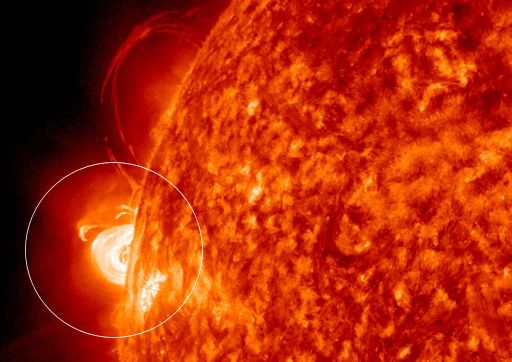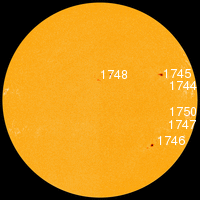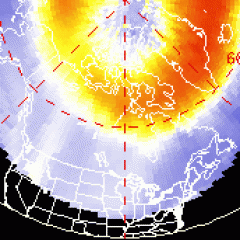RIGHT EXPLOSION ON THE MOON: Recently, a small boulder hit the Moon and exploded with as much energy as 5 tons of TNT. NASA scientists say the explosion was bright enough to see with the naked eye. [full story] [video]
WEEKEND CME STRIKES: Over the weekend, a pair of CMEs hit Earth--one on May 18th (0100 UT) and another on May 19th (2250 UT). The impacts, especially the first one, rattled Earth's magnetic field and sparked Northern Lights visible as far south as Colorado. Some of the brightest appeared over Cape Cod, Massachusetts, where photographer Chris Cook took this self-portrait:
"This is the first time since September 2005 that the lights have been visible from here," says Cook. " It was a beautiful display. During the peak, which lasted about 20 minutes, I could see red and pink pillars with my unaided eye." With only a short exposure, Cook's camera revealed the true depth of color shown above.
More auroras are possible tonight as Earth's magnetic field continues to reverberate from the impacts. NOAA forecasters estimate a 75% chance of polar geomagnetic storms on May 20th. Aurora alerts: text, voice.
WHAT'S IN THE OFFING? A new sunspot is approaching. For the past two days it has been crackling with flares and hurling material over the sun's northeast limb. NASA's Solar Dynamics Observatory photographed these glowing magnetic loops marking the spot of an M1-class explosion during the early hours of May 20th:
The sunspot is on the sun's farside now, but solar rotation is carrying it in our direction. It a day or so it will emerge into view over the sun's eastern limb. Then, forecasters can evaluate its magnetic field and potential for additional flares. Stay tuned. Aurora alerts: text, voice.
HOW TO SEE THE FARSIDE OF THE SUN: If you have an iPhone 4s, iPhone 5, mini iPad or iPad2, you can monitor the farside of the sun. Just download the 3D Sun app for a nearly live 360-degree view of our star.

![]()
Solar wind
speed: 399.7 km/sec
density: 1.7 protons/cm3
explanation | more data
Updated: Today at 1346 UT
![]()
X-ray Solar Flares
6-hr max: C1 1041 UT May21
24-hr: C1 0012 UT May21
explanation | more data
Updated: Today at: 1300 UT
![]()
![]()
![]()
Daily Sun: 20 May 13
![]()
![]()
Sunspot AR1748 has a delta-class magnetic field that harbors energy for X-class solar flares. Credit: SDO/HMI
![]()
![]()
![]()
Sunspot number: 113
What is the sunspot number?
Updated 20 May 2013
Spotless Days
Current Stretch: 0 days
2013 total: 0 days (0%)
2012 total: 0 days (0%)
2011 total: 2 days (<1%)
2010 total: 51 days (14%)
2009 total: 260 days (71%)
Since 2004: 821 days
Typical Solar Min: 486 days
Update 20 May 2013
The Radio Sun
10.7 cm flux: 135 sfu
explanation | more data
Updated 20 May 2013
![]()
![]()
![]()
Current Auroral Oval:
![]()
Switch to: Europe, USA, New Zealand, Antarctica
Credit: NOAA/POES
![]()
![]()
![]()
Planetary K-index
Now: Kp= 1 quiet
24-hr max: Kp= 2 quiet
explanation | more data
![]()
Interplanetary Mag. Field
Btotal: 3.6 nT
Bz: 3.4 nT north
explanation | more data
Updated: Today at 1347 UT
![]()
![]()
![]()
Coronal Holes: 19 May 13
![]()
![]()
Solar wind flowing from this coronal hole should reach Earth on May 23-24. Credit: SDO/AIA.






